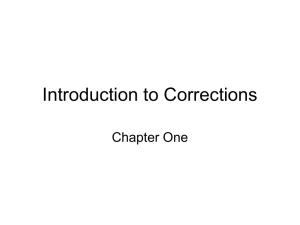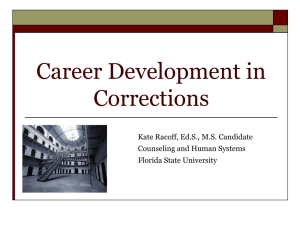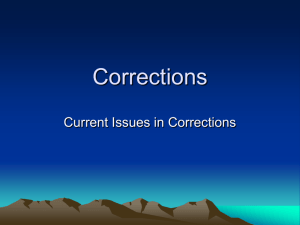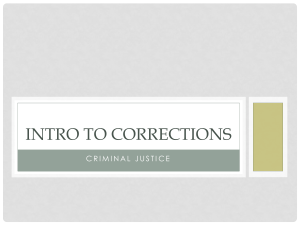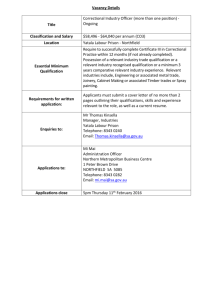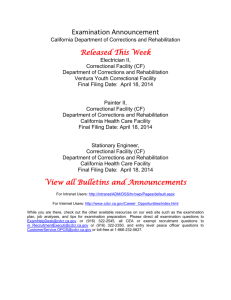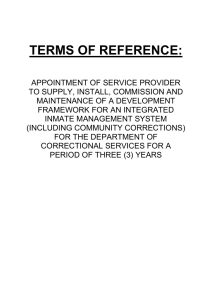Transition Guide - Jones & Bartlett Learning
advertisement
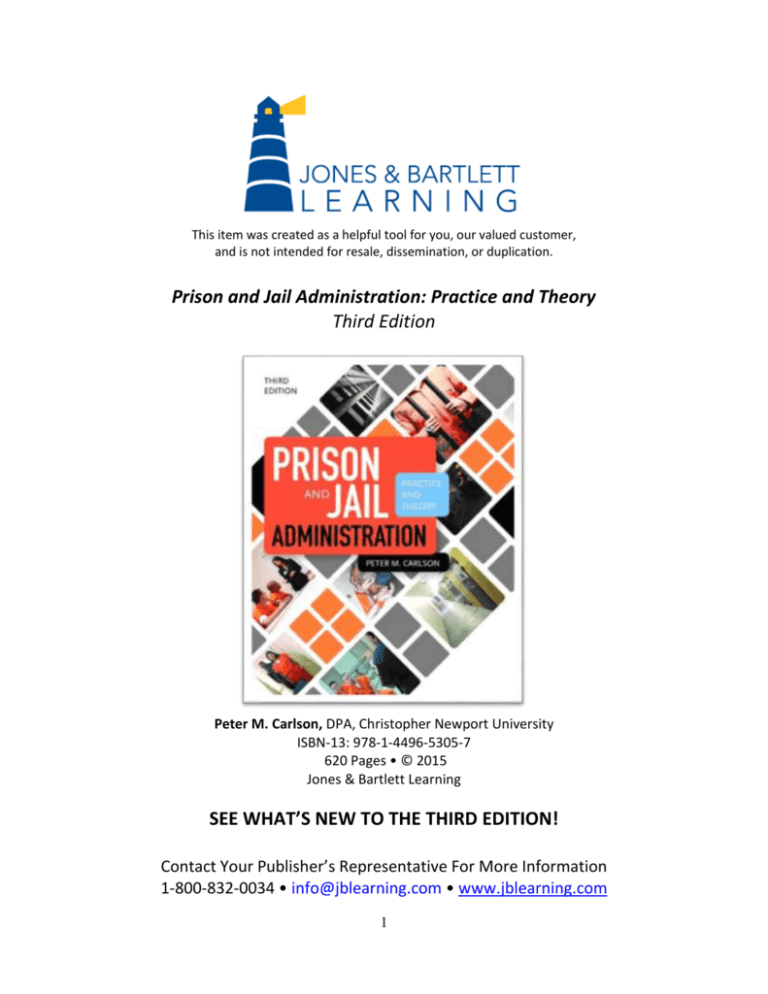
This item was created as a helpful tool for you, our valued customer, and is not intended for resale, dissemination, or duplication. Prison and Jail Administration: Practice and Theory Third Edition Peter M. Carlson, DPA, Christopher Newport University ISBN-13: 978-1-4496-5305-7 620 Pages • © 2015 Jones & Bartlett Learning SEE WHAT’S NEW TO THE THIRD EDITION! Contact Your Publisher’s Representative For More Information 1-800-832-0034 • info@jblearning.com • www.jblearning.com 1 This Transition Guide outlines many of the changes and new content in the Third Edition. Use this guide for an easy transition for the new edition. ABOUT THE TEXT: This is a text that has been a best seller for criminal justice programs. It is useful for undergraduate programs in correctional management as well as graduate programs in management and leadership. The text is designed to engage students and to help them think analytically – Each chapter begins with clearly-stated objectives, ends with Discussion Questions, and points students toward additional resources if they want more detail. All authors are well-known in the field of correctional administration. Chapters are developed in bite-size modules that lend themselves to classroom discussion by topic. Section Introduction case studies have been designed to focus student attention on critical issues in the field. IMPORTANT UPDATES: Correctional experts from academia and the field providing insight to leadership and management of prison and jail facilities Updated material that reflects current state of practice Newly reorganized text structure divided into 15 sections to facilitate the normal 15 week semester Additional chapters added for Female Offenders, The Work of a Correctional Officer, Hiring and Retention of Staff, Institution Pre-Release Programs, and Restorative Justice FOR INSTRUCTORS: PowerPoint Presentations Test Bank materials, including BlackBoard-, Angel-, Moodle-, and Desire2Learnready versions Instructor’s Manual with Lecture Outlines Contact Your Publisher’s Representative For More Information 1-800-832-0034 • info@jblearning.com • www.jblearning.com 2 CHAPTER OUTLINES Table of Contents Comparison to transition from the Second to the Third Edition Second Edition Third Edition Part I: Corrections Past and Present Chapter 1: History of Corrections Part I: Corrections Past and Present Chapter 1: The Legacy of Punishment Chapter 2: American Jails – Dramatic Changes in Public Policy Chapter 3: Prison Architecture Part II: Institution Security and Classification Chapter 2: American Jails Chapter 3: Prison Architecture Chapter 4: Developing Technology Part II: Institutional and Departmental Responsibilities Chapter 5: Custody and Security Chapter 6: Inmate Classification Chapter 7: Educational and Vocational Training Chapter 8: Recreation Chapter 9: Health Care Chapter 10: Mental Health Chapter 11: Religious Programming Chapter 12: Intake, Discharge, Mail, and Documentation Chapter 4: Custody and Security Chapter 5: Inmate Classification Part III: Support Operations in Penal Facilities Chapter 6: Intake, Discharge, Mail, and Documentation NEW AUTHOR! Chapter 7: Food Service Chapter 8: Financial Operations Part IV: Correctional Programing Chapter 9: Rehabilitation NEW AUTHOR! Chapter 10: Correctional Academic, Career, and Reentry Education NEW AUTHOR! Chapter 11: Correctional Recreation Chapter 12: Religious Programming Part V: Inmate Medical and Mental Health Chapter 13: Health Care Chapter 14: Mental Health Chapter 15: Offenders with Specialized Needs Part VI: Offenders with Specialized Needs NEW CHAPTER! Chapter 16: Women Offenders Chapter 17: Sex Offenders Chapter 13: Food Service Chapter 14: Financial Operations Chapter 15: Working with the Media Chapter 16: Community Relations Boards Chapter 17: Political Involvement Part III: Staff Management Chapter 18: Organization and Management Chapter 19: Leadership: Executive Excellence Chapter 20: Governing: Personnel Management Chapter 21: A Day in the Life of a Warden Chapter 22: Diversity of Correctional Officers Chapter 23: Labor Relations 3 Chapter 18: Drug Treatment Part VII: Staff Management Chapter 19: Governing: Personnel Management Chapter 20: A Day in the Life of a Warden NEW CHAPTER! Chapter 21: The World of A Correctional Officer Chapter 22: Labor Relations in Corrections Chapter 23: Changing Diversity of Correctional Officers Part VIII: Developing Human Resources Chapter 24: Organization and Management of the Prison NEW CHAPTER! Chapter 25: Recruitment and Selection in a Correctional Environment Chapter 26: Leadership: Executive Excellence Chapter 24: Preventing Corruption Chapter 25: Sexual Misconduct Chapter 26: Volunteering Part IV: Inmate Management and Programming Chapter 27: Disciplinary Procedures Chapter 27: Preventing Corruption Chapter 28: Staff Sexual Abuse in Confinement Settings Part IX: Inmate Management Chapter 29: Inmate Disciplinary Procedures Chapter 30: Grievance Procedures in Correctional Facilities Chapter 31: Protective Custody Chapter 32: Preventing Suicide Part X: Programs and Operations Unique to Institutions Chapter 33: Prison Work and Industry Chapter 34: Prison Visitation Chapter 35: Gang Management Chapter 36: The Death Penalty Chapter 37: Volunteering Inside Part XI: Emergency Preparedness Chapter 38: Causes of Institutional Unrest Chapter 39: Emergency Management NEW CHAPTER! Chapter 40: Crisis Negotiation in Correctional Settings Chapter 41: Use of Force Part XII: Legal Issues NEW AUTHOR! Chapter 42: Prisoner Access to the Courts NEW AUTHOR! Chapter 43: Compliance with the Constitution Part XIII: External Constituencies Chapter 44: Working with the Media Chapter 45: Community Relations Boards Chapter 28: Grievance Procedures Chapter 29: Protective Custody Chapter 30: Suicide Chapter 31: The Death Penalty Chapter 32: Gang Management Chapter 33: Special Needs Offenders Chapter 34: Sex Offenders Chapter 35: Visitation Chapter 36: Prison Work and Industry Chapter 37: Drug Treatment Chapter 38: Prisoner Access to the Courts Chapter 39: Compliance with the Constitution Chapter 40: Rehabilitation Chapter 41: Reentry Part V: Emergency Preparedness Chapter 42: Causes of Institutional Unrest Chapter 43: Emergency Management Chapter 44: Hostage Situations Chapter 45: Use of Force Part VI: Creating the Future Chapter 46: The Future of Sentencing Chapter 46: Political Involvement Part XIV: Pre-Release and Reentry NEW CHAPTER! Chapter 47: Institution PreRelease Programs Chapter 48: Reentry and Reintegration Chapter 47: Growth of the Private Sector Chapter 48: Corrections in the 21st Century 4 Part XV: Creating the Future NEW CHAPTER! Chapter 49: Restorative Justice Chapter 50: Sentencing and the Future Chapter 51: Developing Technology Chapter 52: Growth of the Private Sector Chapter 53: Corrections in the 21st Century Contact Your Publisher’s Representative For More Information 1-800-832-0034 • info@jblearning.com • www.jblearning.com 5
